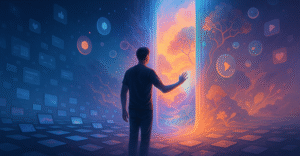
From endless scrolling to real connection: the new language of entertainment
We live in an era where watching is no longer enough. In the midst of digital noise, people are searching for something that breaks the routine, that makes them want to interact, feel, participate. We don’t want more passive content; we want to be part of something. And that is completely changing the rules of the game in entertainment.
For years, consuming meant sitting in front of a screen. Movies, series, commercials, even video games: everything followed a certain pattern. But today, the line between viewer and protagonist is blurring. And technology not only allows it, it’s driving it.
Entertainment is no longer a product. It’s an experience.
Entertainment, as we knew it, is undergoing a profound transformation. It’s no longer enough to produce visually striking or narratively solid content. Modern audiences curious, active, digital demand to live an experience, not just observe from the outside. This evolution is reflected in cultural and commercial phenomena that combine art, technology, and emotion in ways that once seemed exclusive to science fiction.
Today, content is no longer a finished product handed over to the audience for passive consumption. Now, content is a starting point, a gateway to a universe people want to explore, shape, and remember. We see it constantly: concerts using augmented reality so the audience not only listens but participates; marketing campaigns that go beyond traditional videos, allowing users to explore virtual worlds from their mobile devices; interactive art installations, emotionally driven video games, and events where the viewer becomes the protagonist.
These examples aren’t passing trends, they’re signs of a paradigm shift that’s just beginning. The future of entertainment isn’t about making longer content or adding more special effects. The real challenge is making it unforgettable. How? By creating experiences that can’t be replicated or copied, only lived firsthand.
People no longer settle for watching. They want to enter the story.
They want to touch it, walk through it, make decisions within it. The line between viewer and protagonist is fading. And all of this is possible thanks to one key factor reshaping the boundaries of creativity: technology.
Creativity + Technology = Real magic
When creativity meets technology, magic happens. But it’s not fantasy magic, it’s magic made of code, design, and interactive narrative. It’s the ability to turn abstract ideas into tangible digital realities, with textures, sounds, and paths users can explore at their own pace. New digital tools have opened up immense possibilities for creators, developers, and brands. Today, it’s not just about having a good idea, it’s about knowing how to build it so others can live it.
Languages and frameworks like Three.js, Babylon, React Native, WebGL, or APIs specialized in augmented and virtual reality are no longer exclusive tools for tech developers. They’ve become the paintbrushes of a new generation of digital artists who combine storytelling, interaction, and visual design to build experiences. These tools don’t just make something “work” they come to life in creative hands, allowing ideas to transform into inhabitable worlds.
Studios like HyperReality are at the forefront of this movement. They don’t just create games or apps, they build immersive environments tailored to each brand, project, or story. They work with brands that want to leave a mark on their audience, offering content where the user isn’t just a spectator but an active part of the experience. This is where programming becomes art, and strategy becomes emotion.
Because in the end, what truly sticks in a user’s memory isn’t an image or a clever phrase. It’s a feeling, a sensation, a story in which they felt like the protagonist. And when that happens, the connection between brand and person transcends any metric.
Immersion is the new standar
Immersion is no longer a luxury reserved for big productions. It’s an expectation. People want content that speaks to them, surrounds them, surprises them. They want to step into a different universe for a few minutes and have that moment change the way they see a brand, a product, or a story. They want to remember the experience not just consume the message.
Let’s ask ourselves:
¿What if your favorite movie was a 360° space where you choose where to begin? ¿What if a brand told its story through a video game where you shape the ending?
¿What if education stopped being a PowerPoint and became an immersive experience where knowledge is actively explored?
This isn’t science fiction, it’s the present. The technology and creativity are already here. What’s often missing is the willingness to take a bolder approach. Big ideas no longer fit in one format or on a flat screen. They are now designed to be explored to be lived from within. And that requires intentional design, layers of interactivity, and a deep understanding of human behavior in digital environments.
Users want more than information. They want memories, moments they can share, repeat, and remember. That’s why immersion isn’t just a creative tool — it’s the new standard for engagement. If content doesn’t invite users to live it, it will likely be skipped in seconds.
Creativity became interaction
Gone are the days when creative content was just a collection of pretty visuals or catchy phrases. Today, creativity is measured by the ability to generate meaningful interaction. That’s why the brands truly making a difference are the ones that dare to break the mold, experiment, abandon linear storytelling, and hand control to the user.
This shift demands a new mindset, one that thinks not in terms of campaigns, but in terms of shared experiences. One that understands it’s not about having the best product, but about crafting a story where the product plays a role in the user’s world. The most successful brands aren’t just the ones that “communicate well,” but the ones that build universes their audiences want to inhabit.
And the most interesting part is that this doesn’t require huge budgets. What’s really needed is creative vision, a clear strategy, and tech-savvy allies capable of translating ideas into virtual worlds. It takes courage to leave the traditional behind and openness to collaborate with interdisciplinary talent that understands both software and emotions.
This new creativity isn’t about impressing it’s about involving. It’s not about pushing a message, it’s about inviting people to explore it. And that’s what truly creates lasting impact in the user’s mind (and heart).
The audience has changed. ¿Have you?
In this new era, audience attention can’t be bought, it has to be earned. And it’s earned with stories that feel real, with content that can be explored, with universes users want to inhabit. Loyalty is no longer measured in clicks, it’s measured by how long someone stayed in your world, how much they talked about the experience, and how they remember it.
We are at a turning point where entertainment is no longer about how many followers you have or how many views you accumulate. The true value lies in how deeply someone was immersed in your story, how much they shared it, and how they remember it.
So the question is no longer if you should bet on immersive experiences.
The real question is: What are you waiting for to create something no one wants to forget?
Because that’s the new frontier of entertainment.
And the best part… is that it’s already here.
